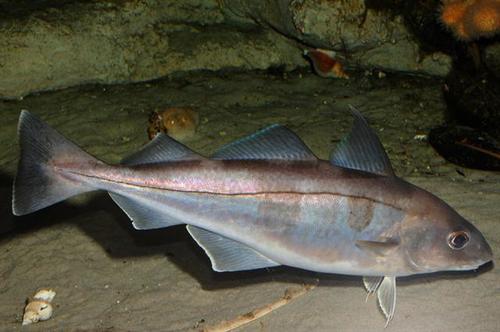
Haddock
The Atlantic bluefin tuna (*Thunnus thynnus*) is a magnificent and highly prized fish species renowned for its size, speed, and commercial value. As one of the largest bony fishes, it plays a critical role in the marine ecosystem. This species has long been important, supporting fisheries for centuries.
3 14 years
Lifespan
50 - 100 cm
Length
Vulnerable
Conservation Status
32 km/h
Swimming speed
Carnivorous
Diet
Seasonal Migration
Migration
Appearance Overview
The Atlantic bluefin tuna is a large, pelagic fish with a streamlined, torpedo-shaped body built for speed and endurance.
Coloration
Dark metallic blue above, silvery white below
Fins
Two dorsal fins, the first depressible into a groove; small, yellow finlets running from the second dorsal and anal fins to the tail
Body Shape
Torpedo-shaped, designed for efficient swimming
Eyes
Relatively small compared to body size
Length
Up to 13 feet (4 meters), commonly 6.5 to 8 feet (2-2.5 meters)
Weight
Up to 2,000 lbs (900 kg), commonly around 550 lbs (250 kg)
Diet
Carnivorous. Feeds on a variety of fish (such as herring, mackerel, and hake), squid, eels, and crustaceans.
Feeding Behavior
Highly active predator, often hunting cooperatively. They can accelerate quickly to pursue prey and sometimes leap out of the water.
Social Behavior
Forms large schools, especially when young. Schooling behavior can be complex, sometimes segregating by size. Older, larger individuals may be more solitary or form smaller groups.
Commercial Relevance
Extremely high value, particularly in the sushi and sashimi markets. Individual fish can sell for thousands or even hundreds of thousands of dollars.
Conservation measures
Subject to international fishing quotas and regulations managed by organizations like ICCAT. Marine Protected Areas (MPAs) and gear restrictions are also used.
Status
Varies by population; the Western Atlantic stock is considered Endangered, while the Eastern Atlantic and Mediterranean stock is considered Near Threatened.
Threats
Historical overfishing is the primary threat. Bycatch in fisheries targeting other species, climate change impacts on prey distribution, and habitat degradation are also concerns.
Habitat Distribution
Depth Range
Surface waters down to depths of over 3,000 feet (1,000 meters), although they spend most of their time in the upper layers of the ocean.
Geographic Range
Found throughout the North Atlantic Ocean, including the Mediterranean Sea. The two main populations are the Western Atlantic and Eastern Atlantic/Mediterranean stocks.
Preferred Environment
Primarily pelagic, inhabiting temperate and subtropical waters. They are highly migratory, following warm water currents and prey availability.
Reproduction and Life Cycle
Breeding Habits
Spawning occurs in warm waters, with the Gulf of Mexico being a major spawning ground for the western Atlantic population, and the Mediterranean Sea for the eastern Atlantic population.
Development Stages
Eggs hatch into larvae, which are planktonic. They grow rapidly, undergoing several developmental stages before reaching juvenile and, eventually, adult form.
Fecundity
Highly fecund; a single female can release up to 30 million eggs per spawning season.
Maturity Age
Varies between populations, generally between 4-8 years for the Western Atlantic stock and slightly earlier for the Eastern Atlantic stock.
Faqs about Haddock
Where can I find Atlantic bluefin tuna?
Atlantic bluefin tuna are found in both the western and eastern Atlantic Ocean, as well as the Mediterranean Sea.
How long do Atlantic bluefin tuna live?
They can live up to 40 years, although this is less common due to fishing pressure.
Are Atlantic bluefin tuna warm-blooded?
Yes, they are warm-blooded, able to maintain a body temperature higher than the surrounding water, which allows for high activity levels.
How fast can Atlantic bluefin tuna swim?
They can reach speeds of up to 43 mph (70 km/h) in short bursts.
Do Atlantic Bluefin Tuna Migrate?
Atlantic bluefin tuna are a highly migratory species, undertaking long journeys across the ocean for feeding and spawning.
Where do they spawn?
The Western Atlantic stock typically spawns in the Gulf of Mexico, while the Eastern Atlantic stock spawns in the Mediterranean Sea.
How many eggs do they lay?
Females can release millions of eggs per spawning season, although the survival rate of eggs and larvae is low.
When do they become adults?
The age at maturity varies, but generally, they reach maturity between 4-8 years old.
Copyright @ Nature Style Limited. All Rights Reserved.
 English
English